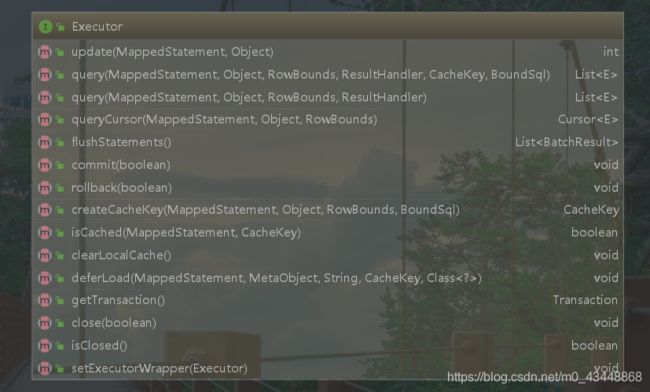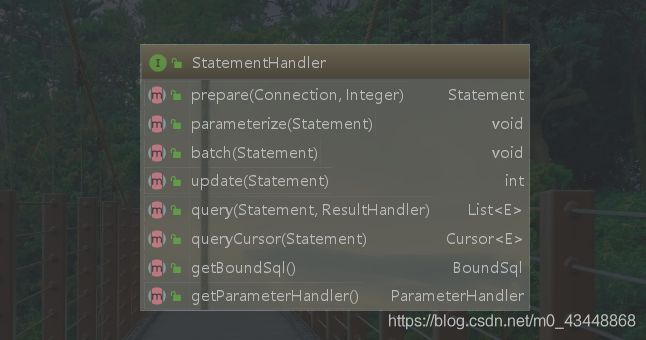MyBatis中拦截器(Interceptor)是什么?怎么用?其实现原理?
简介
拦截器(Interceptor)是用来改变或者扩展MyBaits原有的功能,例如可以通过拦截器机制来分析项目中存在那些慢SQL(统计SQL执行时间),分页工具PageHelper正是基于该机制来完成的分页。MyBatis对外提供的扩展点共有四个,可以进行拦截的接口和方法如下:
Executor(接口中所有方法都可以拦截)
StatementHandler(接口中所有方法都可以拦截)
org.apache.ibatis.executor.parameter.ParameterHandler(接口中所有方法都可以拦截)
StatementHandler(接口中所有方法都可以拦截)
怎么用?
这里首先需要熟悉四个东西,分别是Interceptor接口以及Invocation和@Intercepts、@Signature注解。
public interface Interceptor {
// 该方法就是MyBatis在使用前面提到的四个接口中的方法时进行回调的方法。
Object intercept(Invocation invocation) throws Throwable;
// 用来为目标对象创建代理对象的方法,通常不需要覆写。
default Object plugin(Object target) {
return Plugin.wrap(target, this);
}
// 设置一些属性
default void setProperties(Properties properties) {
// NOP
}
}
Invocation 的定义信息很简单,其共有三个属性,分别为target(目标对象)、method(方法)、args(方法参数)以及相关Getter/Setter方法,还有一个proceed方法,就是执行目标方法。
public class Invocation {
private final Object target; // 目标对象
private final Method method; // 执行方法
private final Object[] args; // 方法参数
public Invocation(Object target, Method method, Object[] args) {
this.target = target;
this.method = method;
this.args = args;
}
public Object getTarget() {
return target;
}
public Method getMethod() {
return method;
}
public Object[] getArgs() {
return args;
}
public Object proceed() throws InvocationTargetException, IllegalAccessException {
return method.invoke(target, args);
}
}
@Intercepts和@Signature注解要合在一起来看,@Intercepts注解只有一个属性,即value,其返回值类型是一个@Signature类型的数组。这代表我们可以配置多个@Signature注解。
@Signature注解其实就是一个方法签名,其共有三个属性,分别为:type、method、args。type指接口的class,method指接口中的方法名,args指的是方法参数类型(该属性返回值是一个数组)。
public @interface Intercepts {
/**
* 方法签名
*/
Signature[] value();
}
public @interface Signature {
/**
* 用来指定接口类型
*/
Class<?> type();
/**
* 用来指定方法名
*/
String method();
/**
* 用来指定方法参数
*/
Class<?>[] args();
}
小伙伴们看上面的解释可能还是不太明白,没关系,接下来我们就编码实战!
Talk is cheap. Show me the code
第一步:定义一个类实现MyBatis的Interceptor 接口。通过@Intercepts以及@Signature注解来指定我们要拦截的接口为Executor的query方法,通过指定args,即方法参数类型来确定是哪个query方法。下面的通过@Signature指定的update、commit方法都一样。
package com.tech.mybatis.interceptors;
import org.apache.ibatis.cache.CacheKey;
import org.apache.ibatis.executor.Executor;
import org.apache.ibatis.mapping.BoundSql;
import org.apache.ibatis.mapping.MappedStatement;
import org.apache.ibatis.plugin.Interceptor;
import org.apache.ibatis.plugin.Intercepts;
import org.apache.ibatis.plugin.Invocation;
import org.apache.ibatis.plugin.Signature;
import org.apache.ibatis.session.ResultHandler;
import org.apache.ibatis.session.RowBounds;
import java.util.Arrays;
@Intercepts(
{
@Signature(type = Executor.class, method = "query",
args = {
MappedStatement.class, Object.class, RowBounds.class, ResultHandler.class,
CacheKey.class, BoundSql.class}),
@Signature(type = Executor.class, method = "update",
args = {
MappedStatement.class, Object.class}),
@Signature(type = Executor.class, method = "commit",
args = {
boolean.class})}
)
public class CustomizedInterceptor implements Interceptor {
@Override
public Object intercept(Invocation invocation) throws Throwable {
Object[] args = invocation.getArgs(); // 获取方法参数
System.out.println("拦截到 " + invocation.getMethod().getName() + " 执行!方法参数为:" + Arrays.toString(args));
return invocation.proceed();
}
}
第二步:编写启动类(数据库DDL,JavaDO,Mapper详见附录)。需注意的是一定要将自定义的拦截器注册到MyBatis中,这里我们用代码的方式来添加。
package com.tech.mybatis.interceptors;
import com.alibaba.druid.pool.DruidDataSource;
import com.xxx.spring.entity.TUserDO;
import org.apache.ibatis.plugin.Intercepts;
import org.apache.ibatis.session.SqlSessionFactory;
import org.mybatis.spring.SqlSessionFactoryBean;
import org.mybatis.spring.annotation.MapperScan;
import org.springframework.context.annotation.AnnotationConfigApplicationContext;
import org.springframework.context.annotation.Bean;
import org.springframework.context.annotation.Configuration;
import org.springframework.jdbc.datasource.DataSourceTransactionManager;
import org.springframework.transaction.TransactionManager;
import org.springframework.transaction.annotation.EnableTransactionManagement;
import javax.sql.DataSource;
/***
* 演示Mybatis拦截器使用{@link Intercepts}
* @author 君战
* */
@Configuration
@EnableTransactionManagement
@MapperScan("com.tech.mybatis.interceptors")
public class MyBatisInterceptorDemo {
public static void main(String[] args) {
// 创建注解驱动应用上下文
AnnotationConfigApplicationContext context = new AnnotationConfigApplicationContext();
context.register(MyBatisInterceptorDemo.class); // 将当前类作为配置类注册
context.refresh(); // 刷新应用上下文
TUserMapper userMapper = context.getBean(TUserMapper.class); // 通过应用上下文来获取TUserMapper接口实现类实例
TUserDO userDO = new TUserDO();
userDO.setAge(22);
userDO.setUserName("君战");
userMapper.insert(userDO); // 执行TUserMapper的insert方法。
}
/**
* 将SqlSession注册到Bean中,MyBatis在为Mapper接口生成代理对象时需要用到
*/
@Bean
public static SqlSessionFactory sqlSessionFactory() throws Exception {
SqlSessionFactoryBean factoryBean = new SqlSessionFactoryBean();
factoryBean.setDataSource(dataSource());
factoryBean.afterPropertiesSet();
SqlSessionFactory sessionFactory = factoryBean.getObject();
org.apache.ibatis.session.Configuration configuration = sessionFactory.getConfiguration();
configuration.addInterceptor(new CustomizedInterceptor()); // 一定要将自定义拦截器添加到Mybatis配置中心Configuration
return sessionFactory;
}
/*
* 配置数据源
*/
@Bean
public static DataSource dataSource() {
DruidDataSource dataSource = new DruidDataSource();
dataSource.setUrl("jdbc:mysql://localhost:3306/study?useSSL=false");
dataSource.setUsername("root");
dataSource.setPassword("123456");
return dataSource;
}
/*
* 配置事务管理,关于事务管理器的作用可以查看我的另一篇博文-
* 《从源码轻松理解什么是事务传播特性?Spring事务传播是如何实现的?Spring事务传播行为有哪些?》
* 地址:https://blog.csdn.net/m0_43448868/article/details/112115749
*/
@Bean
public TransactionManager transactionManager() {
return new DataSourceTransactionManager(dataSource());
}
}
XML方式注册自定义拦截器。
<plugins>
<plugin interceptor="com.tech.mybatis.interceptors.CustomizedInterceptor">plugin>
plugins>
执行main方法,可以看到控制台已经输出拦截器的打印语句。
拦截到 update 执行!方法参数为:[org.apache.ibatis.mapping.MappedStatement@70cf32e3, com.xxx.spring.entity.TUserDO@5a59ca5e]
21:32:11.117 [main] DEBUG com.tech.mybatis.interceptors.TUserMapper.insert - ==> Preparing: INSERT INTO t_user VALUES(null,?,?)
21:32:11.160 [main] DEBUG com.tech.mybatis.interceptors.TUserMapper.insert - ==> Parameters: 君战(String), 22(Integer)
21:32:11.171 [main] DEBUG com.tech.mybatis.interceptors.TUserMapper.insert - <== Updates: 1
拦截到 commit 执行!方法参数为:[true]
了解到MyBatis的拦截器怎么用之后,接下来我们就分析下MyBatis中的拦截器是如何实现的。
MyBatis拦截器机制底层实现分析
我们只需要分析一个扩展点的拦截器机制实现即可,因为其余三个的实现基本一致。这里我们就来分析下Executor扩展点的拦截器机制实现。
在DefaultSqlSessionFactory的openSessionFromDataSource方法中,
// DefaultSqlSessionFactory#openSessionFromDataSource
private SqlSession openSessionFromDataSource(ExecutorType execType, TransactionIsolationLevel level, boolean autoCommit) {
Transaction tx = null;
try {
final Environment environment = configuration.getEnvironment();// 获取MyBatis的环境对象
final TransactionFactory transactionFactory = getTransactionFactoryFromEnvironment(environment); // 根据环境对象获取事务工厂
tx = transactionFactory.newTransaction(environment.getDataSource(), level, autoCommit);
final Executor executor = configuration.newExecutor(tx, execType); // 重点是这里,在创建SqlSession之前首先通过configuration来创建了Executor
return new DefaultSqlSession(configuration, executor, autoCommit);
} catch (Exception e) {
closeTransaction(tx); // may have fetched a connection so lets call close()
throw ExceptionFactory.wrapException("Error opening session. Cause: " + e, e);
} finally {
ErrorContext.instance().reset();
}
}
在newExecutor方法中,创建完Executor 后,会调用interceptorChain的pluginAll方法来对Executor进行增强(如果应用程序定义了拦截器,并且在拦截器的@Intercepts({@Signature(…)})注解中配置的是Executor的某个方法)。
// Configuration#newExecutor
public Executor newExecutor(Transaction transaction, ExecutorType executorType) {
executorType = executorType == null ? defaultExecutorType : executorType;
executorType = executorType == null ? ExecutorType.SIMPLE : executorType;
Executor executor;
if (ExecutorType.BATCH == executorType) {
// 如果是批量Executor
executor = new BatchExecutor(this, transaction);
} else if (ExecutorType.REUSE == executorType) {
// 如果是可复用的Executor
executor = new ReuseExecutor(this, transaction);
} else {
// 默认使用SimpleExecutor
executor = new SimpleExecutor(this, transaction);
}
if (cacheEnabled) {
executor = new CachingExecutor(executor);
}// 创建完Executor之后,调用interceptorChain的pluginAll方法来对Executor进行增强
executor = (Executor) interceptorChain.pluginAll(executor);
return executor;
}
InterceptorChain 类就定义了一个集合用来存放用户注册的所有Interceptor实现,在pluginAll方法中遍历每一个Interceptor实现类,调用其plugin方法,传入目标对象。
package org.apache.ibatis.plugin;
import java.util.ArrayList;
import java.util.Collections;
import java.util.List;
public class InterceptorChain {
private final List<Interceptor> interceptors = new ArrayList<>();
// 遍历用户注册的所有拦截器实现类的plugin方法,注意这是一个链式增强
public Object pluginAll(Object target) {
for (Interceptor interceptor : interceptors) {
target = interceptor.plugin(target);
}
return target;
}
// 将Interceptor 实现类实例保存进interceptors 集合中
public void addInterceptor(Interceptor interceptor) {
interceptors.add(interceptor);
}
// 获取一个不可修改的interceptors 集合的副本
public List<Interceptor> getInterceptors() {
return Collections.unmodifiableList(interceptors);
}
}
因为我们没有重写plugin方法,所以执行的是Interceptor接口默认的plugin方法,在默认实现中调用Plugin的wrap方法。
// Interceptor#plugin
default Object plugin(Object target) {
return Plugin.wrap(target, this);
}
既然如此,那么我们就着重分析下Plugin类,因为在其wrap方法中基本调用到了该类的所有方法以及使用到了所有属性。需要注意的是该类实现了JDK动态代理中的InvocationHandler接口。
public class Plugin implements InvocationHandler {
private final Object target; // 目标对象
private final Interceptor interceptor; // 拦截器对象
private final Map<Class<?>, Set<Method>> signatureMap; // 方法签名,Key为接口Class,value为方法
private Plugin(Object target, Interceptor interceptor, Map<Class<?>, Set<Method>> signatureMap) {
this.target = target;
this.interceptor = interceptor;
this.signatureMap = signatureMap;
}
public static Object wrap(Object target, Interceptor interceptor) {
// 首先根据拦截器来获取其关注的类以及类中的方法
Map<Class<?>, Set<Method>> signatureMap = getSignatureMap(interceptor);
Class<?> type = target.getClass();
// 根据用户在@Intercepts中@Signature注解中配置的类型来和目标对象接口进行匹配
Class<?>[] interfaces = getAllInterfaces(type, signatureMap);
if (interfaces.length > 0) {
// 使用JDK动态代理
return Proxy.newProxyInstance(
type.getClassLoader(),
interfaces,
new Plugin(target, interceptor, signatureMap));
}
return target;
}
@Override
public Object invoke(Object proxy, Method method, Object[] args) throws Throwable {
try {
// 首先根据传入的方法的定义类类型来判断当前拦截器是否感兴趣
Set<Method> methods = signatureMap.get(method.getDeclaringClass());
if (methods != null && methods.contains(method)) {
// 如果当前拦截器感兴趣,则调用其intercept方法
return interceptor.intercept(new Invocation(target, method, args));
}
return method.invoke(target, args);// 否则直接执行目标方法
} catch (Exception e) {
throw ExceptionUtil.unwrapThrowable(e);
}
}
private static Map<Class<?>, Set<Method>> getSignatureMap(Interceptor interceptor) {
Intercepts interceptsAnnotation = interceptor.getClass().getAnnotation(Intercepts.class); // 获取到拦截器中的@Intercepts注解数据
if (interceptsAnnotation == null) {
throw new PluginException("No @Intercepts annotation was found in interceptor " + interceptor.getClass().getName());
}
Signature[] sigs = interceptsAnnotation.value(); // 获取@Intercepts注解中的所有@Signature
Map<Class<?>, Set<Method>> signatureMap = new HashMap<>();
for (Signature sig : sigs) {
// 遍历每一个@Signature注解
Set<Method> methods = signatureMap.computeIfAbsent(sig.type(), k -> new HashSet<>());
try {
Method method = sig.type().getMethod(sig.method(), sig.args()); // 以@Signature注解中配置的type来获取其method,根据@Signature注解中配置的method以及args
methods.add(method); // 将获取到的方法保存进methods集合中。
} catch (NoSuchMethodException e) {
throw new PluginException("Could not find method on " + sig.type() + " named " + sig.method() + ". Cause: " + e, e);
}
}
return signatureMap;
}
private static Class<?>[] getAllInterfaces(Class<?> type, Map<Class<?>, Set<Method>> signatureMap) {
Set<Class<?>> interfaces = new HashSet<>();
while (type != null) {
// 获取目标类型的所有接口并遍历,需注意的是这里传递的实际类型(type)是接口实现类,
// 并不是接口本身。如果是接口本身,那么type.getInterfaces()获取到的接口只有父接口了。
for (Class<?> c : type.getInterfaces()) {
if (signatureMap.containsKey(c)) {
// 如果signatureMap中包含该接口,则将该接口添加到interfaces集合中
interfaces.add(c);
}
}// 如果当前类存在父类,对其父类进行相同的查找
type = type.getSuperclass();
}// 最后返回合适的接口
return interfaces.toArray(new Class<?>[interfaces.size()]);
}
}
总结
MyBatis中的拦截器机制其实就是基于JDK的动态代理实现,在创建完目标对象后,循环用户注册的所有拦截器实现,然后对每个拦截器的@Intercepts中@Signature注解中配置的类型来和目标对象所实现的接口进行匹配,如果匹配上了,则说明目标对象是当前拦截器所关注的。
在代理对象执行的时候,对目标方法进行拦截判断是不是当前拦截器所关注的方法,如果是则执行拦截器的intercept方法,否则直接执行目标方法。
附录
数据库DDL
CREATE TABLE `t_user` (
`id` int(11) NOT NULL AUTO_INCREMENT,
`user_name` varchar(30) DEFAULT NULL,
`age` int(255) DEFAULT NULL,
PRIMARY KEY (`id`)
) ENGINE=InnoDB AUTO_INCREMENT=6 DEFAULT CHARSET=utf8;
TUserMapper
package com.tech.mybatis.interceptors;
import com.xxx.spring.entity.TUserDO;
import org.apache.ibatis.annotations.Insert;
import org.apache.ibatis.annotations.Select;
import org.apache.ibatis.annotations.Update;
import java.util.List;
/**
* @author: 君战
**/
public interface TUserMapper {
@Select("SELECT * FROM t_user")
List<TUserDO> selectAll();
@Insert("INSERT INTO t_user VALUES(null,#{userName},#{age})")
Integer insert(TUserDO userDO);
@Update("UPDATE t_user SET age = #{age} WHERE user_name = #{userName}")
Integer update(TUserDO userDO);
}
TUserDO
package com.xxx.spring.entity;
/**
* @author: 君战
**/
public class TUserDO {
private Integer id;
private String userName;
private Integer age;
public Integer getId() {
return id;
}
public void setId(Integer id) {
this.id = id;
}
public String getUserName() {
return userName;
}
public void setUserName(String userName) {
this.userName = userName;
}
public Integer getAge() {
return age;
}
public void setAge(Integer age) {
this.age = age;
}
}



